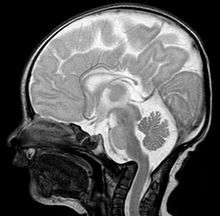Basilar invagination
Basilar invagination is invagination (infolding) of the base of the skull that occurs when the top of the C2 vertebra migrates upward. It can cause narrowing of the foramen magnum (the opening in the skull where the spinal cord passes through to the brain). It also may press on the lower brainstem.[1]
This is similar to Chiari malformation. That, however, is usually present at birth.
Symptoms
Symptoms vary depending on whether the spinal cord, brain stem, nerves or their blood supply is affected by the pressure.
Symptoms become apparent when the neck is bent. They include:
- Posterior head pain
- Neck weakness
- Periods of confusion
- Dysarthria (difficulty swallowing or talking due to loss of muscle control)
- Dizziness
- Loss of sensation
- Cranial nerve disturbance
- Loss of the ability to know how joints are positioned
- Lhermitte's sign ('electric shock sensation' down spine and/or to the extremities when the neck is flexed forward)
- Weakness of the arms and legs
- Orthostatic hypotension
- Patients will go into a pool and notice that below their belly button the water is not as cold as it is above.
Complications from this can include hydrocephalus, pseudotumor cerebri or syringomyelia because it blocks the flow of fluid around the brain and spinal cord.
Causes and Risk Factors
Basilar invagination can be present at birth. If the condition develops after birth, it is usually the result of injury or diseases. If due to injury, about half the time it is caused by vehicle or bicycle accidents; 25% of the time by falls and 10% of the time by recreational activities such as diving accidents.
It also occurs in patients with bone diseases, such as osteomalacia, rheumatoid arthritis, Paget's disease, Ehlers-Danlos syndrome, Marfan syndrome, and osteogenesis imperfecta.
Diagnosis

A doctor will base his or her diagnosis on the symptoms the patient has and the results of tests, including:
- An X-ray
- Magnetic resonance imaging (MRI), which usually provides the most information
- Computed tomography (CT) scan [2]
Treatment
If there aren't neurological symptoms (such as difficulties moving, loss of sensation, confusion, etc.) and there is no evidence of pressure on the spinal cord, a conservative approach may be taken such as:
- Drugs, such as aspirin, without steroids to relieve inflammation
- Cervical traction, in which the neck is pulled along its length, thus relieving pressure on the spinal cord
- Using a neck collar or cervical-thoracic suit
If there is pressure on the spinal cord or life-threatening symptoms are present, surgery is recommended.
Notes
See also
- Chiari Malformation
- Syringomyelia
- Hydrocephalus
- Rheumatoid arthritis
- Ehlers-Danlos Syndrome
- Marfan Syndrome
- Dysautonomia
| ||||||||||||||||||||||